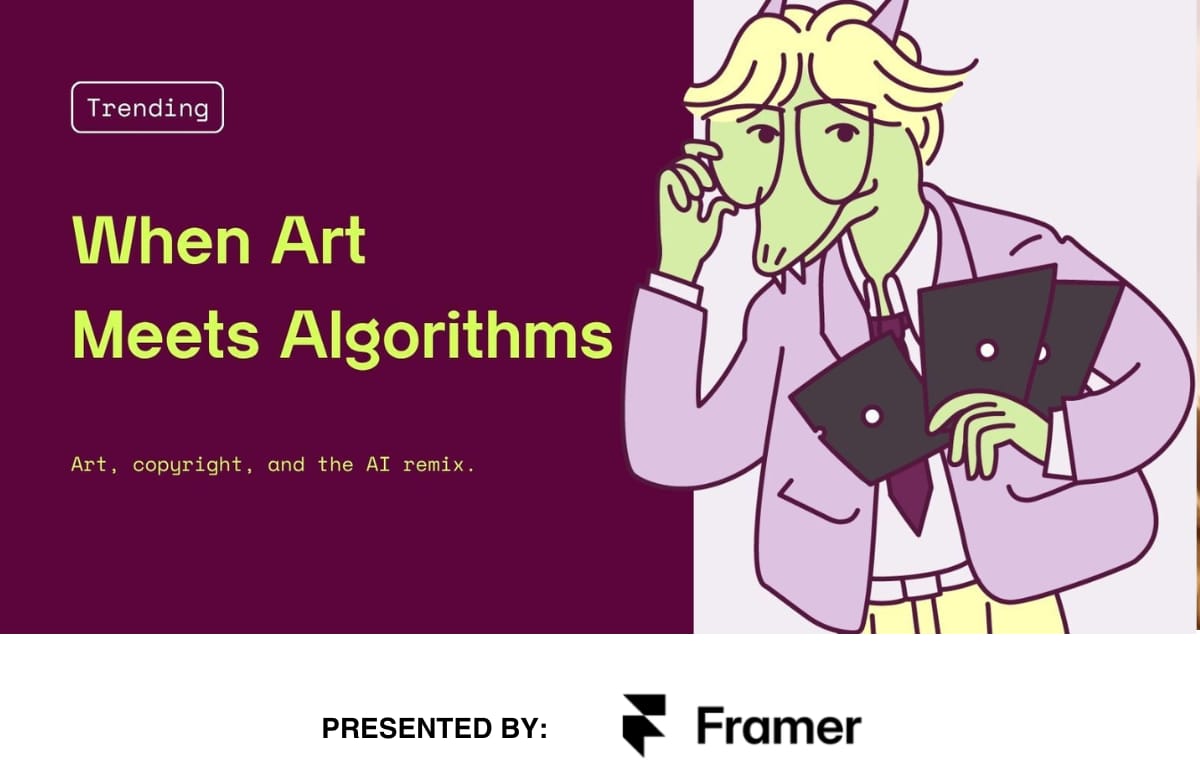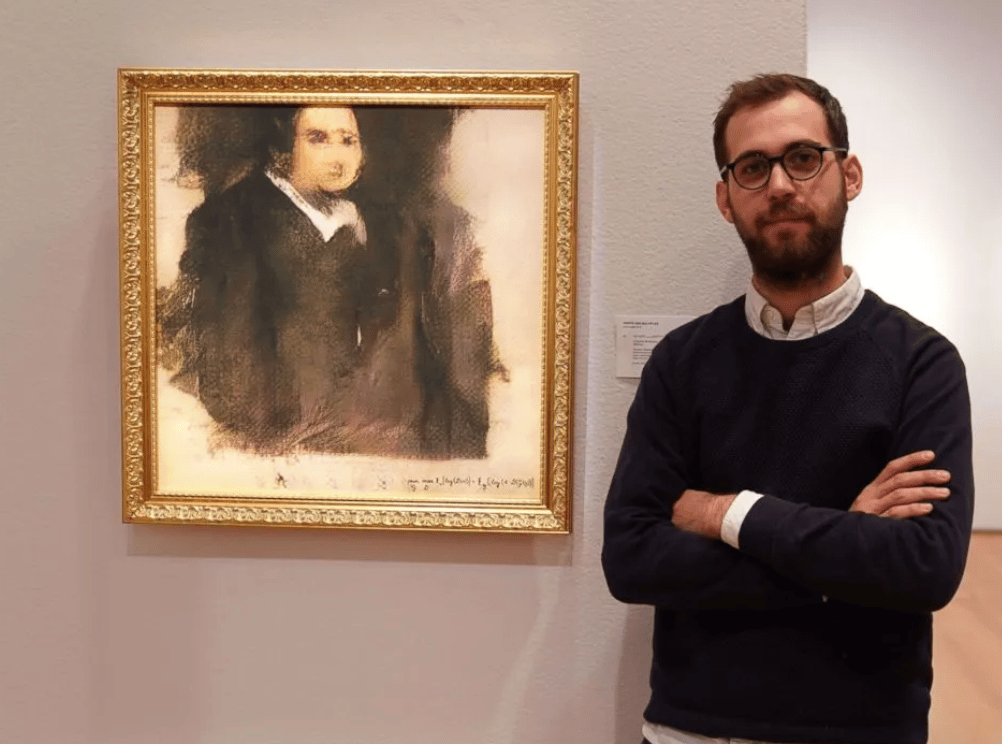- Roko's Basilisk
- Posts
- When Art Meets Algorithms
When Art Meets Algorithms
Plus: Smart rings launch, Maps gets Gemini, and Amazon takes on Perplexity.
Here’s what’s on our plate today:
🎨 Can AI make real art? Christie’s auction sparks lawsuits and a global debate.
🧠 Stream launch, Gemini upgrades Google Maps, and Amazon sues Perplexity.
🧰 No-code builders, open-source validators, and concept remixing.
🗳️ What role should AI play in art?
Let’s dive in. No floaties needed…

Launch fast. Design beautifully. Build your startup on Framer—free for your first year.
First impressions matter. With Framer, early-stage founders can launch a beautiful, production-ready site in hours. No dev team, no hassle. Join hundreds of YC-backed startups that launched here and never looked back.
One year free: Save $360 with a full year of Framer Pro, free for early-stage startups.
No code, no delays: Launch a polished site in hours, not weeks, without hiring developers.
Built to grow: Scale your site from MVP to full product with CMS, analytics, and AI localization.
Join YC-backed founders: Hundreds of top startups are already building on Framer.
Eligibility: Pre-seed and seed-stage startups, new to Framer.
*This is sponsored content

The Laboratory
How AI is redefining art’s value and preservation
Since the beginning of civilization, humans have channeled their emotions, beliefs, fears, and hopes through art. From prehistoric cave paintings to digital installations, art allows people to leave a trace of their consciousness, to record and reinterpret experience, and to make sense of beauty, suffering, and time itself.
Art, then, can be seen as a repository of human history, thought, and progress. At times, art has also been used as a means to challenge authority, inspire empathy, or build solidarity by giving shape to ideas that define an era.
Beyond its face value, art also commands monetary valuations of millions due to its ability to invoke emotions, capture moments, or represent cultural identities. The monetary value of art is a collective effort and depends on reputation, provenance, rarity, cultural significance, institutional endorsement, and market demand.
For example, the Mona Lisa’s value lies less in its brushstrokes and more in the myths surrounding its painter and the rich history that carried it to its home in the Louvre.
Up until now, famous pieces of art were as much about the artists as it was about the artwork. However, generative AI is redefining the relationship between art, artists, and the value of artwork.
The Christie’s flashpoint
Recently, thousands of artists called on Christie’s, a renowned auction house known for selling fine art, antiques, and luxury collectibles, to cancel its planned sale of AI-generated artworks, arguing that the technology used to create them amounts to “mass theft”.
The event, titled Augmented Intelligence, represents a broader shift in how art is viewed by appraisers, patrons, and artists, as it is among the first major auctions devoted entirely to AI art. It features 20 pieces, priced between $10,000 and $250,000, by creators such as Refik Anadol and the late AI art pioneer Harold Cohen.
The event is also a major step in determining the value of art generated by computer systems that have been trained on the work of human artists, many of whom fail to reap the benefits of their work.
However, this was not the first protest against AI-generated art.
A snapshot of resistance to machines in art
In 2022, artists on ArtStation, an online platform that served as a portfolio and networking site, protested the rise of AI-generated images on the platform by posting a viral “No To A.I. Images” stop sign, accusing AI tools of stealing creative labor.
When ArtStation removed protest images and defended its neutrality toward AI art, backlash intensified. The company later introduced a ‘NoAI’ tag, allowing artists to opt out of AI training; however, users criticized it for being optional and tedious to apply.
For many, the very idea of machine-generated artwork goes against the premise of art, which is seen as the culmination of things that inspire an artist.
Critics of AI-generated art argue that generative AI does not think or feel. It operates using neural networks, which are complex mathematical systems. These models are fed massive datasets of existing text and images, learning statistical patterns. When a user provides a prompt, the AI generates images based on these learned patterns. The technology acts like an aggregator and remixer of its training data, not a conscious creator with lived experience.
Even Forbes has called the technology “a solution to a problem that never existed”. Arguing that generative AI artwork could devalue the work of human artists as they compete with the low-quality output of machines. Forbes further argues that artwork created by generative AI primarily serves those seeking to churn out content rapidly and inexpensively by cutting human creativity out of the process.
While their position is understandable, many disagree with the outlook, believing that AI merely mirrors the user, as such, can only produce visuals based on learned information, and that it is human imagination that guides and refines the results.
According to Adobe’s blog post, the use of AI in art isn’t new: pioneers like Vera Molnár were experimenting with computer-generated works as early as 1968.
Today, AI art appears in major institutions such as New York’s Museum of Modern Art, where Refik Anadol’s data-driven installations are displayed, and it features in exhibitions and auctions worldwide. Additionally, universities are also incorporating AI into art education, and the technology is reshaping how artists create and challenging long-held definitions of art itself.
Inside the museum debate
For galleries and curators, as Paola Antonelli, a senior curator at MoMA and director of the museum’s research and development, puts it, “the technology is not the art”. However, according to The New York Times, some artists like Refik Anadol have embarked on plans to build an AI art museum.
Anadol’s upcoming museum, Dataland, will feature its own AI model for artists, developed with Google and Nvidia and trained on half a billion licensed images. Anadol envisions the museum as a communal space where AI art can thrive, arguing that traditional museums lack the resources to showcase the medium’s full potential.
However, some museums remain cautious; Marshall N. Price of Duke University’s Nasher Museum said they are adopting a wait-and-see approach, noting that earlier NFT experiments lost momentum and recalling that an attempt to have ChatGPT curate an exhibition produced disappointing results.
Regardless of how AI-generated art is viewed by the beholder, it has had a real-world impact on artists and the value of their artwork.
Market reality shaping prices, bubbles, and IP risks
According to a report from Time magazine, Portrait of Edmond Belamy, created by the Paris-based art collective Obvious, was sold for $432,500, nearly 45 times its high estimate. The portrait was made using an algorithm trained on 15,000 historical portraits. It is reported to be the first AI-generated artwork sold at a major auction house when it was auctioned at Christie’s during its October 23–25 Prints & Multiples sale in 2018.
However, the real definition and place of AI art may lie in neither of the two opposing views. An article from The Harvard Gazette argues that defining art isn’t static and that as technology evolves, so too must our understanding of what is considered art.
While the debate is yet to be settled, generative AI is projected to reach $40 billion by 2033, growing at a CAGR of 28.9% suggesting that the art market's growth is tied to the broader AI technology boom, making it vulnerable to the same bubble fears that surround the tech industry at large.
However, for generative AI to continue this projected growth in art, it will have to overcome legal and regulatory hurdles. Lawsuits from artists over copyright infringement are already in progress and could fundamentally alter the business models of AI companies.
For instance, if an algorithm generates a piece of art, the question of ownership has to be settled. Is the creator the programmer, the prompt writer, or the model owner?
And even if the question of ownership is settled, the proliferation of AI art could undermine the value of skill, craftsmanship of human creators. Oversupply could further erode the value of artworks since scarcity is a core driving factor of artworks pricing structure.
Enterprises that use AI-generated art for branding or products may face legal challenges over the provenance of that art. Additionally, the spread of deepfake technology erodes trust and poses a significant reputational risk. As such, the true potential of generative AI, for art or for slop, is yet to be realized, and so is its impact on artists, curators, and art galleries.
Preserving what's sacred
During and after World War II, the Allied Monuments, Fine Arts, and Archives (MFAA) program, known as the Monuments Men, worked to protect Europe’s cultural heritage from Nazi looting and wartime destruction.
The corps, comprising museum curators, art historians, and architects from Allied nations, identified and safeguarded monuments, cataloged stolen works, and recovered vast art caches hidden in salt mines and castles.
Their mission was not only preservation but also a moral and legal act of restitution, repairing the immense cultural losses inflicted during one of history’s largest systematic art thefts.
The Monuments Men once stood guard over humanity’s creative heritage. Decades later, as generative models flood the world with new images, their challenge takes a digital form. If every algorithm can create, what becomes rare? And more importantly, what remains sacred enough to be called art, worth preserving?
TL;DR
Christie’s sparks backlash: Thousands of artists accuse the auction house’s AI art sale of “mass theft”, reigniting the debate over creativity, consent, and copyright.
Museums split on AI art: Institutions like MoMA embrace AI installations, while others hesitate—citing failed NFT hype and questions about artistic authorship.
Market surges, ownership blurs: AI art sales hit hundreds of thousands, but lawsuits over data use, authorship, and provenance could derail its $40B growth path.
From Monuments Men to model ethics: The fight to protect art’s soul has shifted from rescuing paintings to defending human creativity from algorithmic dilution.


Headlines You Actually Need
Ex-Meta team launches Stream: A new smart ring lets users take voice notes and control audio with subtle gestures — no screens required.
Google Maps gets Gemini boost: Gemini AI is coming to Maps, making turn-by-turn navigation more conversational and fully hands-free.
Amazon backs lawsuit against Perplexity: The tech giant joins a publisher’s case accusing the AI startup of scraping and summarizing news without permission.

The context to prepare for tomorrow, today.
Memorandum distills the day’s most pressing tech stories into one concise, easy-to-digest bulletin, empowering you to make swift, informed decisions in a rapidly shifting landscape.
Stay current, save time, and enjoy expert insights delivered straight to your inbox.
Streamline your daily routine with the knowledge that helps you maintain a competitive edge.
*This is sponsored content

Friday Quick Poll
🗳️ What role should AI play in art? |

Weekend To-Do
Mindstudio’s AI app builder: No-code, drag-and-drop app builder for AI workflows. Great for prototyping ideas or building internal tools.
AI training data with Giskard: an Open-source tool for finding biases, bugs, and edge cases in ML datasets and LLM pipelines.
Clipdrop’s new Reimagine XL tool: Instantly remix and re-style any image using a simple prompt or variation tool. Surprisingly powerful for concept design.
Rate This Edition
What did you think of today's email? |






